Integrated Pest Management Package on Olive
IPM package in practice
The use of IPM package to control olive fruit fly is based on three elements:
• Implementation of the best monitoring system for the olive fruit fly.
• Adoption of the “Attract and Kill” system to control B. olea.
• Adoption of adequate cultural methods (proper timing for olive harvesting) to escape from the high level of olive fruit fly.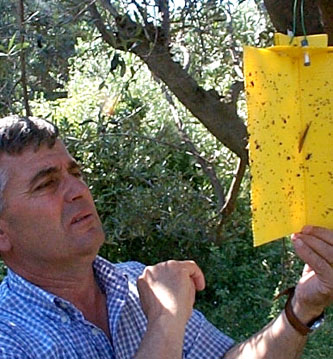
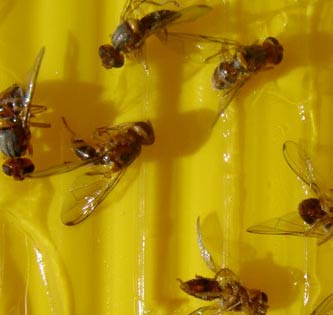
Monitoring of Olive Fruit Fly
In order to find out where the olive fruit fly is, to understand what it is doing and to assess the effectiveness of the applied control measures, it is essential to implement an effective Monitoring system. Adult olive fruit fly populations are usually monitored with yellow sticky traps baited with sex pheromones and ammonium bicarbonate. Sex pheromones are attractive to male flies, whereas ammonium bicarbonate is primarily attractive to females. Both male and females are attracted to the trap’s yellow color. If used correctly, traps can provide information about:
• The presence or absence of olive fruit flies in olive groves
• Pest populations and their dynamics.
This information, together with a periodic damage assessment on samples of olive fruits, help field operators to decide on the optimum time for the olive fruit fly control. Traps used for monitoring purposes can be different from those used as a control measure. The traps should be hung on the south side of the olive tree on the outside of the canopy. Flies caught per trap/5 days are noted. The traps should be hung as high as possible at the beginning of the olive fruit fly activity. In Albania, the most productive monitoring results are being achieved by using traps purchased in Italy.
“Attract and Kill” method to control Olive Fruit Fly
How Does It Work?[b]
The so-called “Attract and kill” method[/b] consists of a green colored bag containing 70g of ammonium bicarbonate. On the outside the bag is covered with a pyrethroid insecticide (deltamethrin) and is also baited with a sex pheromone dispenser containing 80mg of spirochetal. Flies are attracted by the pheromones and the ammonium bicarbonate and land on the pyrethroid baited bags, receiving a lethal dose of insecticide. The “Attract and Kill” method does not require the use of sticky traps and therefore continues to be effective for an extended period of time. The devices used for this method have been purchased in Greece.
How Many Devices Will You Need?
If 80-120 olive trees are planted per hectare, one device for every tree is needed. If the olive trees have a small or medium size canopy, one device has to be attached every other tree. The larger the treated area, the better the results achieved. It is advisable to treat areas of at least 5 hectares. Growers with smaller groves should co-operate with their neighbors in order to treat an adequately sized area.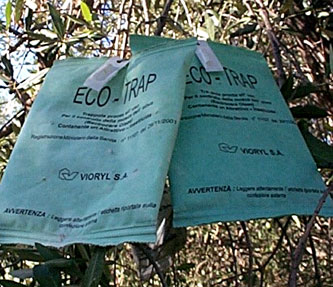
When Should You Use The Target Devices?
The system is designed to provide season-long protection against the attacks of the olive fruit fly. The device should be hung on the tree before the beginning of olive fruit fly’s sexual activity and before the first attacks. The onset of sexual activity is indicated by an increasing catch in the pheromone-baited traps. In most Albanian locations this usually occurs at the end of June, as shown by the monitoring of the olive fruit fly activity. Do not delay your application. Apply in good time to prevent the population of olive fruit fly getting out of control. Replace the target device again during the first day of September when the population density of olive fruit fly start to be higher.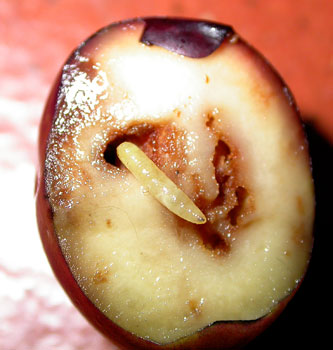
The adoption of this method is economically convenient as it doesn’t require any follow-up fieldwork. It is an effective treatment against olive fruit flies which does not require the use of pesticides, therefore not leaving poisonous chemicals on fruits and leaves. The method is respectful of the ecosystem and it produces an adequate environment for the growth of other useful insects. It is completely biological and complies with the European regulations (2092/91),so it can successfully be used in olive organic agriculture cultivation. 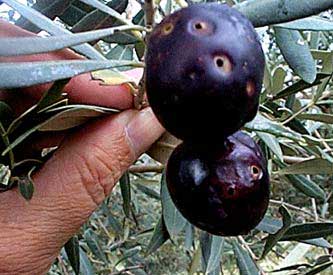
The cost of the “Attract and Kill” method in Albania has been of approximately 1,00 USD per tree per year. It reduced by 99.5% the amount of insecticides used for olive protection (15 mg a.i. per tree per year, compared to 3 g, in case of bait sprays). The extension of the use of the “Attract and Kill” method and the mass production of the required material (especially traps) is expected to result in a considerable reduction in its cost.
[b]Cultural methods to escape from the high levels of olive fruit flies[/b]
Olive harvest can be properly timed to maximize yields and minimize olive fruit flies infestation. When the temperature drops below 300C, olive fly infestation increases and affects the oil quality due to the increase in the oil acidity percentage. If growers succeed in selecting the optimal time to simultaneously maximize yields and minimize olive fruit flies infestation, the use of chemicals to control olive flies can be reduced.
To find the optimal time when these two processes can be balanced several researches were done with the main olive varieties in Albania (Kalinjoti and Frantoi) identifying the period at which oil formation is at its high, collecting olive fruit samples at ten day intervals starting from the first days of September till the end November and monitoring the level of olive fruit fly infestation during autumn. The effect of harvest timing has to be adapted to each area and to each cultivar, according to the specific geographic and environmental conditions.
DOWNLOAD THE BROCHURE PDF
English (0.9 MB)Spanish (1.0 MB)








 COUNTRY OF ORIGIN
COUNTRY OF ORIGIN